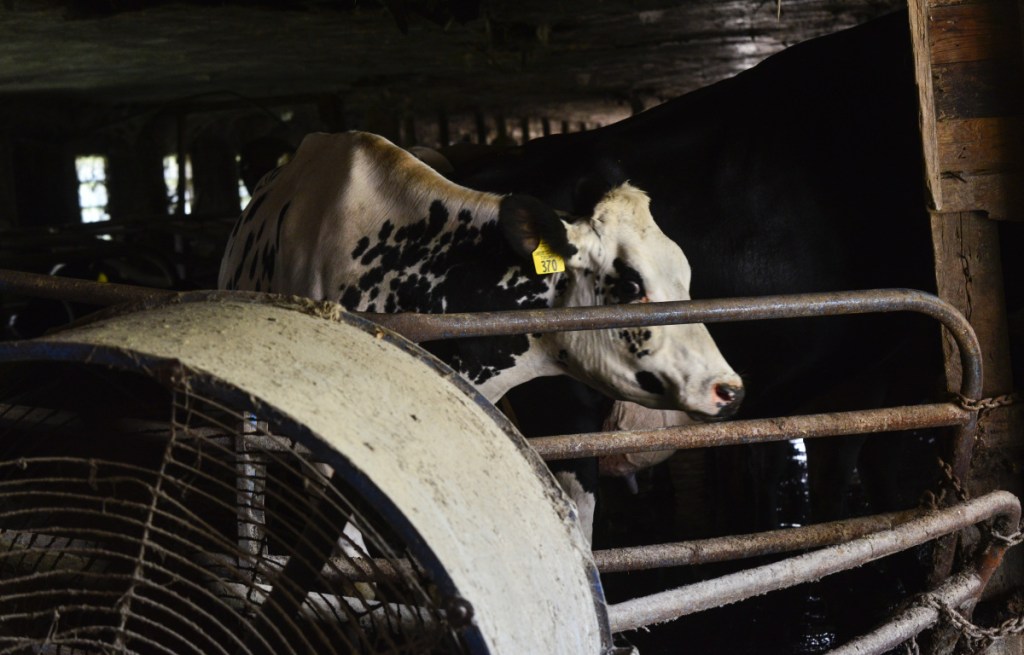VERNON, Vt. — It’s not just humans who don’t like the heat and humidity.
One Vernon dairy farm is doing its best to keep its bovines as cool and comfortable as they can during this unusually long stretch of hot, humid weather.
Art Miller, one of three partners in Miller Farm Inc. of Vernon, said Monday that the heat puts the cows off their feed, and as a result, milk production drops.
“Heat is really hard on cows,” he said. The black and white registered Holsteins, particularly the predominantly black ones, really heat up in the noontime sun, he said. “Production is down 10 percent. They’ve gone off their feed. They just stand around and drink water,” he said.
Cows drink a lot of water ordinarily, and when it’s hot, conventional farm wisdom has it that one cow can drink a barrel of water a day – that’s 55 gallons for each cow. The farm provides plenty of water in 150-gallon tubs, which are constantly replenished.
Last week, there was a stretch of days with temperatures in the 90s, and humidity that was super oppressive, and production dropped between 10 and 15 percent, he said.
To encourage their appetite, the cows are put out to pasture earlier in the morning, and then put in the free-stall barns during the heat of the day, with giant fans running.
Miller, who runs the farm with his brother, Peter, and co-owner Keith Franklin, said cows actually like weather in the 40s best of all. Even in the heat of summer, the cows are grazing twice a day.
Miller said he’s no scientist, but it certainly seems like Vermont’s summers are getting hotter. “They seem to be, but I’m no meteorologist,” he said.
“If you could ask cows whether they were prefer zero or 100, they would say zero,” said Miller, as the 180 cows stood in the barns’ cool shade, and in front of giant four-foot-wide fans, during another day of 90-degree weather.
The Miller Farm ships its organic milk to Stonyfield Dairy, which turns it into its famous yogurt. The farm, which was established 102 years ago, has been organic for about 10 years.
Miller said one major reason for putting the cows in during the heat of the day was that cows had a habit of congregating together in the heat, making themselves hotter, rather than spreading out in the pasture.
Franklin and Miller said the cows need little convincing to come in at noontime and get in out of the sun. Milking is done at 4 a.m. and 4 p.m., and after that, it’s green pastures for them.
In Florida, where temperatures in the 90s are the norm, some dairy farmers use misting machines to keep their cows cool, he said. But Miller said that has to be done carefully. It’s fine if the mist is targeted to the cow’s back, but there shouldn’t be so much water that it runs down the cow’s sides and onto its udder, where all the dampness can promote infection.
Miller said the farm has not lost cows due to the heat, but a cow showing heat stress will pant – letting its tongue loll out.
“Shade is huge for them,” he said.
Copy the Story LinkSend questions/comments to the editors.



Success. Please wait for the page to reload. If the page does not reload within 5 seconds, please refresh the page.
Enter your email and password to access comments.
Hi, to comment on stories you must . This profile is in addition to your subscription and website login.
Already have a commenting profile? .
Invalid username/password.
Please check your email to confirm and complete your registration.
Only subscribers are eligible to post comments. Please subscribe or login first for digital access. Here’s why.
Use the form below to reset your password. When you've submitted your account email, we will send an email with a reset code.